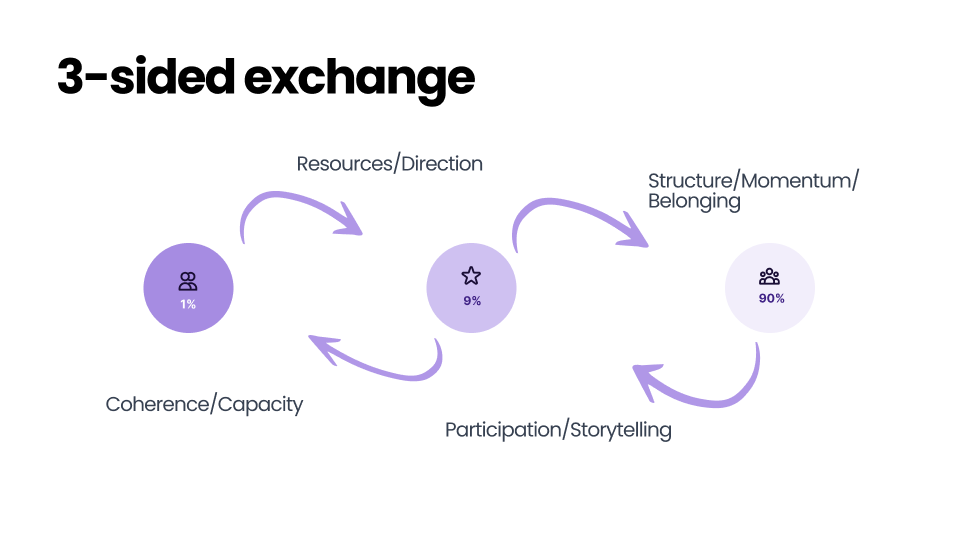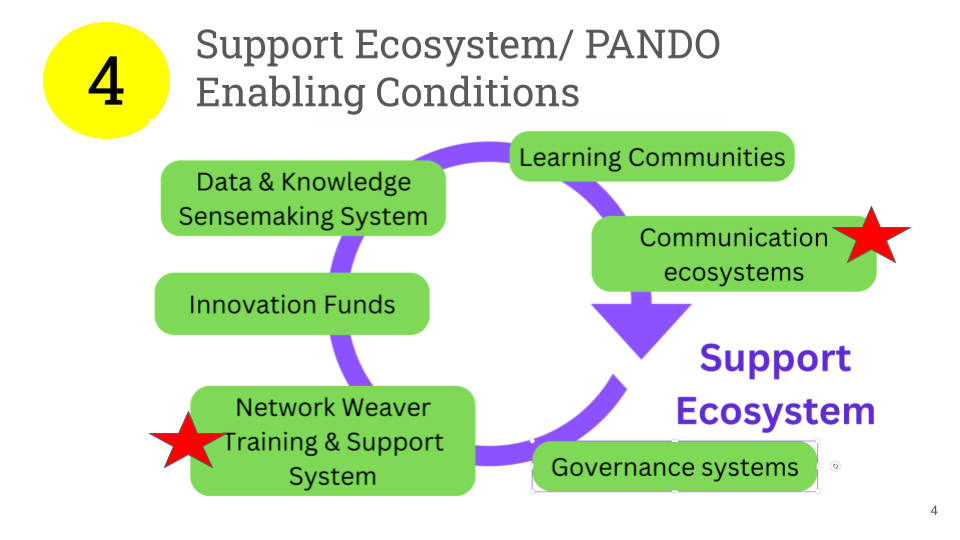TLDR: Effective collaboration across networks of groups requires supporting the "middle layer" of participants - network catalysts who step into leadership roles but aren't part of the core team. Without these critical participants, networks struggle to build capacity or maintain coherence as they grow.

In today's connected world, our biggest problems need many groups working together to solve them. But when different organizations try to work together without anyone in charge, we face a basic challenge: how do we organize our work and move in the same direction without having one central leader?
Sometimes networks begin by replicating traditional leadership; a ‘backbone organization’ creates a ‘hub and spoke network. Others start as several fragmented initiatives.
We see this problem clearly when groups try to work together on big issues like climate change, poverty, or health crises. These teams often face these problems:
- Groups keep information to themselves instead of sharing it
- Different teams do the same work without knowing it
- Projects lose energy without clear structure
- Small teams struggle to grow bigger
The result is many separate projects that each do good work but don't create big change together. We don't need more organizations - we need better ways to connect the ones we already have.
Silos and Duplication of Efforts Undermine Collective Work
Think about climate change work. Hundreds of groups work on different parts of the problem - some make policies, others create new technology, work with communities, or push companies to do better. Each has its own partners, funders, and supporters.
The situation today looks like a broken system where:
- Local groups don't know what's happening with national policies
- Researchers create solutions that never reach the people who could use them
- Companies work on sustainability without talking to communities
- Funders can't see the whole picture of what's being done
It's like a city with neighborhoods but no roads connecting them. With no way to travel between areas, good ideas stay stuck in one place.
For example, in the book "Team of Teams," General McChrystal learned that the military's old way of organizing into separate departments looked like it worked well, but actually caused expensive communication problems. When his forces broke down the walls between different groups and let teams work together more freely, they could move fast and make decisions across thousands of soldiers on three different continents much better than the old top-down system.
Catalysts Make Network Coordination Possible
Socialroots' research built on the core-periphery model of networks as articulated by The Together Institute and Michel Bachmann. Every network has three types of participants:
- Core Team (1%): Full-time staff who lead and provide resources
- Middle Layer ‘Network Catalysts’ (9%): People who can lead some parts but not full-time
- Extended Community (90%): People who join occasionally and need clear direction
As we interviewed 100's of network participants, we used this model to sort their responses. Our research validated that the middle 9% is key to growing networks. These people:
- Know their field and have connections to different groups
- Have some time to help, but not full-time
- Want meaningful ways to contribute without quitting their day jobs
- Often connect different communities together
Our most important insight came from looking at the exchanges between each type of network participant. The 9% network catalysts create spaces for the 90% to find what they are looking for (resources, connection, belonging, ways to be heard, etc), and help synthesize their stories, insights, and needs to inform network strategy. Without support for this middle layer, networks usually just have the core team sending newsletters to everyone else, with no real way for people to get more involved.
How Socialroots Supports Network Catalysts
This research informed the architecture of the digital commons we’re building at Socialroots. Four main features help networks get things done:
- Easy Group Creation :The middle 9% can create and run small topic-focused groups that aren’t just channels. These spaces have clear boundaries, permissions that support emerging leaders, and communication channels for people who can't work full-time.
- Network/Ecosystem Maps: Visual maps show connections between autonomous groups helping people can see how their work fits into the bigger picture. Maps and group directories show not only the people but the other organizations and networks in the ecosystem. A Kumu integration offers a dynamic map of connections based on participation. This helps align work and reduce duplication of effort without needing one central boss.
- Different Ways to Join In: Instead of forcing people to choose between just reading emails or navigating real-time chats or other tools built for working full-time, Socialroots gives multiple ways to contribute based on how much time you have.
- Shared Leadership: The system supports temporary and co-leadership roles to match people's interests and available time. This provides flexibility and spreads coordination work across many people instead of bottlenecking a few.
Practical Applications
The Socialroots approach works well for:
Different Sectors Working Together: Organizations focused on different parts of the same issue (like affordable housing) can keep their unique focus while working toward shared goals. Policy makers, builders, community groups, and banks can align their work through connected subgroups.
Building New Fields: New areas like sustainable economics benefit from connecting people across different organizations. The platform allows knowledge sharing without requiring one central organization.
Local-to-Global Networks: Projects with local, regional, and global parts can maintain independence at each level while ensuring a coherent strategy. Local innovations can spread more easily through the network.
Call to Action
To implement these ideas in your own work:
- Map your network: Identify the organizations you're already connected to and understand where coordination gaps exist.
- Support your middle 9%: Recognize the people showing leadership potential and create specific roles for them.
- Start small: Begin with 2-3 high-priority areas where better coordination would create immediate value.
- Join the Socialroots community: Connect with others trying similar approaches and help develop better tools and practices.
The power to solve our biggest problems isn't about creating more organizations - it's about helping the ones we have work better together.
How do I help/join?
Join our next Socialroots Community event here
Support us by donating here
Other resources
- "New Power" by Jeremy Heimans and Henry Timms - Shows how connected communities are changing how power works
- "Impact Networks" by David Ehrlichman - Practical guide for network builders
- "Team of Teams: New Rules of Engagement for a Complex World" by Stanley McChrystal et. al.
- Socialroots Knowledge Base - Collection of case studies and best practices





